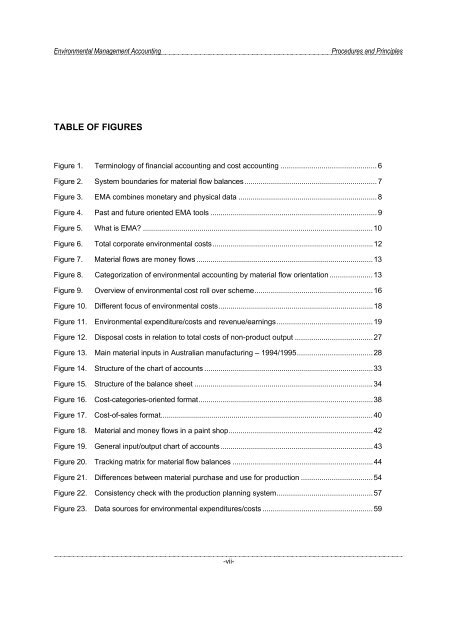Environmental Management Accounting Procedures and Principles
Environmental Management Accounting Procedures and Principles
Environmental Management Accounting Procedures and Principles
You also want an ePaper? Increase the reach of your titles
YUMPU automatically turns print PDFs into web optimized ePapers that Google loves.
<strong>Environmental</strong> <strong>Management</strong> <strong>Accounting</strong><br />
<strong>Procedures</strong> <strong>and</strong> <strong>Principles</strong><br />
TABLE OF FIGURES<br />
Figure 1. Terminology of financial accounting <strong>and</strong> cost accounting ............................................... 6<br />
Figure 2. System boundaries for material flow balances................................................................. 7<br />
Figure 3. EMA combines monetary <strong>and</strong> physical data .................................................................... 8<br />
Figure 4. Past <strong>and</strong> future oriented EMA tools .................................................................................. 9<br />
Figure 5. What is EMA? ..................................................................................................................10<br />
Figure 6.<br />
Total corporate environmental costs...............................................................................12<br />
Figure 7. Material flows are money flows .......................................................................................13<br />
Figure 8.<br />
Figure 9.<br />
Figure 10.<br />
Figure 11.<br />
Categorization of environmental accounting by material flow orientation.....................13<br />
Overview of environmental cost roll over scheme..........................................................16<br />
Different focus of environmental costs............................................................................18<br />
<strong>Environmental</strong> expenditure/costs <strong>and</strong> revenue/earnings...............................................19<br />
Figure 12. Disposal costs in relation to total costs of non-product output ......................................27<br />
Figure 13. Main material inputs in Australian manufacturing – 1994/1995.....................................28<br />
Figure 14. Structure of the chart of accounts ...................................................................................33<br />
Figure 15. Structure of the balance sheet ........................................................................................34<br />
Figure 16.<br />
Figure 17.<br />
Figure 18.<br />
Figure 19.<br />
Cost-categories-oriented format......................................................................................38<br />
Cost-of-sales format.........................................................................................................40<br />
Material <strong>and</strong> money flows in a paint shop.......................................................................42<br />
General input/output chart of accounts...........................................................................43<br />
Figure 20. Tracking matrix for material flow balances .....................................................................44<br />
Figure 21. Differences between material purchase <strong>and</strong> use for production ...................................54<br />
Figure 22.<br />
Consistency check with the production planning system...............................................57<br />
Figure 23. Data sources for environmental expenditures/costs ......................................................59<br />
-vii-




